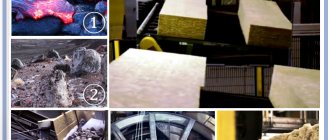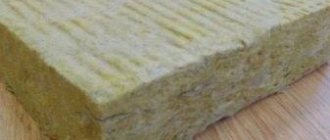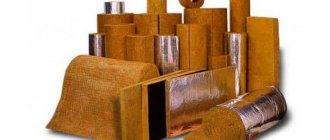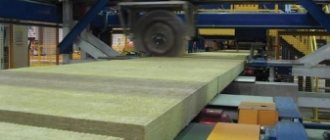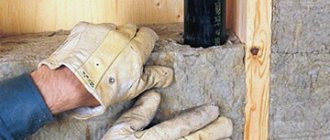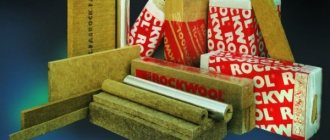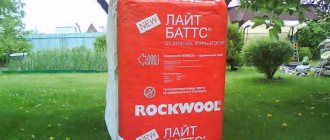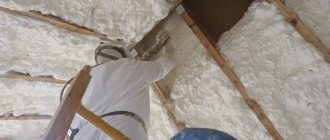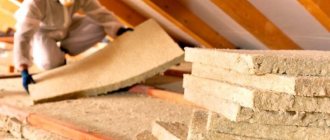Last time we talked about roll insulation. Today, in continuation of this topic, we will take a detailed look at Rockwool insulation: dimensions, characteristics, scope of application. The entire Rockwool line of mineral wool is made from a volcanic rock called basalt. Therefore, such thermal insulation is also called basalt or stone wool. Production was established in Denmark and Sweden in 1937. Since that time, the company has expanded significantly and opened its branches in Europe, Asia, and North America. Today it is the most famous brand among mineral wool insulation, the high quality of which is beyond doubt.
Rockwool - stone wool insulation
Rockwool is a recognized leader in the production of natural basalt insulation. The company has scientific and technical centers and is constantly working to improve its products.
The most popular product item is basalt insulation. The material includes natural elements: basalt, andesite and other components of natural origin. The production technology is based on a natural process - the solidification of mountain minerals after a volcanic eruption.
After melting and gradual cooling, stone wool acquires a fibrous structure. Thin threads are not deformed - they are arranged randomly. Dense weaves provide the necessary strength and shape retention for a long time.
The high technical and operational qualities of Rockwool insulation explain its demand in construction:
- insulation of external walls of different houses: frame, wooden, permanent;
- possibility of thermal insulation from inside the room;
- insulation of floors, roofs, attics.
The Rockwool assortment includes both universal materials and insulation with pronounced specific qualities - for certain structural elements.
A little about the company
This trademark was registered in 1936 and correctly appears as ROCKWOOL. The manufacturer insists on writing in Latin letters, without quotation marks, only in capital letters.
The company was founded on the basis of a company registered in Denmark in 1909, engaged in the extraction and sale of coal and rocks. The company also produced roofing tiles.
The first insulation was released in 1936-1937, at which time the name Rockwool was registered. It literally translates as “stone wool”, which accurately reflects the features of thermal insulation materials based on stone wool - they are light and warm, like natural wool, but at the same time strong and durable - just like stone.
Today Rockwool is not just one of the best manufacturers of insulation, but also a company that produces innovative products in its field. This is due to the presence of the company’s own research centers, the developments of which are introduced into production processes.
The production of insulation under this brand is currently established in 18 countries and 28 factories located in them. The company has representative offices in 35 countries. In Russia, the products appeared in the early 70s, initially for the needs of the shipbuilding industry. Due to its high quality, it gradually became widespread in other areas, primarily construction.
The official representative office that appeared in 1995 made the brand even more popular. Today, there are 4 factories in Russia that produce products under the Rockwool brand. They are located in the Leningrad, Moscow, Chelyabinsk regions and the Republic of Tatarstan.
Review of the qualities of wall insulation
Basalt thermal insulation in the form of mats is considered the best option for arranging a wall pie of frame walls . The material combines the main properties: heat capacity, vapor permeability, resistance to deformation and fire.
Heat-saving effect and vapor permeability
The main advantage of “stone” mats, which determines their scope of application, is their high thermal insulation ability. Rockwool basalt wool does an excellent job of regulating the temperature inside the house. In winter, insulation protects the room from frosty air, and in summer it keeps it cool and prevents heat from penetrating inside. The insulating mats are tightly joined together. This technology prevents the appearance of cracks - cold bridges .
Elastic stone wool sheets are easy to install; additional fasteners are not needed - the layers are installed in a pre-prepared frame.
An undeniable advantage of basalt insulation is its “breathing” ability. Unlike foam insulators, natural wool is breathable . The frame does not create a thermos effect, and excess accumulated moisture is removed through the micropores of the insulation.
Moisture resistance and sound insulation
As reviews show, stone wool used for walls or on the floor delays the spread of impact and airborne noise . By choosing the optimal insulation layer, you can achieve a reduction in the sound effect within the range of 43-62 dB.
An undeniable advantage of basalt insulation is its hydrophobicity. Stone does not get wet - drops do not linger on the surface, but roll down. The material does not absorb water, which means it retains its thermal insulation qualities. This property of insulation is very important for external installation and the use of cotton wool for arranging “wet” areas: saunas, baths.
The inability to accumulate water and the mineral base of the heat insulator exclude the emergence of a favorable environment for the development of parasitic microflora, the appearance of rodents and insects. The stone wool composition is not characterized by processes of rotting, decomposition, or mold formation . Rockwool basalt mats can be reused - their characteristics and qualities are practically unchanged over time.
Useful: We calculate the structure and structure of the walls of a frame house
Fire safety and environmental friendliness
The key factor in using insulation in residential buildings is operational safety. In this regard, stone wool has succeeded.
Basalt can withstand high temperatures and does not ignite; the heat insulator begins to melt when heated from +1000°C. Rockwool insulation complies with the following safety classes:
- KM0 – completely safe;
- NG – non-combustible materials.
Due to its fire resistance, stone wool insulation is often used as an effective fire barrier .
Rockwool thermal insulator is considered an environmentally friendly product. No harmful components are involved in its production - only a natural mineral and a water repellent that ensures moisture resistance. Stone wool, regardless of operating conditions, does not emit hazardous substances into the environment. In terms of environmental friendliness, Rockwool basalt insulation is ahead of most alternative polymer-based insulation materials. Its use is permissible inside the home .
Summary
The fundamental differences in mineral insulation are insignificant. The emphasis on properties is justified only in product advertising:
- Paroc – all elastic;
- Izovol for a bath - with a reinforced heat-reflecting layer;
- blow-in cotton wool Isover – penetrates into any nooks and crannies;
- Ursa Pureone – thanks to a natural binder, it is environmentally friendly.
But the cost may vary significantly. The situation is complicated by the different values of measures in the price lists.
In this review, prices are reduced to a single indicator (RUB/m³). Therefore, just choose the most profitable option for the current period.
And remember: in the case of mineral wool, it is not the price that heats, but the volume.
Technical characteristics of different types
Rockwool offers the appropriate type of insulation to solve various problems. Thermal insulation materials differ in density, size, strength, cost and other characteristics.
The most popular positions:
- Light Butts. Designed for private housing construction, insulation of non-load-bearing structures, apartments. A distinctive feature is light weight, the ability to compress the thickness up to 70%. Light Butts uses Flexi technology - to simplify installation, one edge of the sheet is springy. Density – 36 kg/m3, thermal conductivity – 0.039 W/(m*k), vapor permeability – 29 mg/(mhPa). The material is not designed for heavy loads.
- Light Butts Scandic . In terms of technical and operational characteristics, Scandic is similar to ordinary Light Butts. The differences are in size, packaging and application. The length of the Scandic reaches 80-120 cm, the XL modification simplifies installation over large areas . The improved heat insulator is sealed in vacuum-compressed packaging - this reduces logistics costs. Scandic can be used in any home insulation systems.
- Rockwool Economy. A budget solution while maintaining all the advantages of basalt wool . Characteristics: density – 23-29 kg/m3, vapor permeability – from 0.3 mg/(mhPA), size – 100*60 cm, thickness – 50 mm, 100 mm.
In addition to universal offerings, Rockwool has developed a whole line of narrowly focused products:
- façade works – Butts Optima, Butts series;
- insulation of walls under plaster – FrontRock S, FasRock LL, Lamella;
- ventilated façade – Venti Butts;
- for panel structures, monolithic buildings - Concrete Element, brickwork - Cavity Butts;
- insulation of fireplaces - Fire Butts, baths - Sauna Butts.
The Rockwool official website provides a complete list of materials broken down by category of use.
Lite Batts
Peculiarities
As I said above, the manufacturer does not recommend using Floor Batts for wall insulation.
For these purposes, there is a special material Light Butts. It consists of lightweight mineral wool slabs. The main difference between this brand and Floor Butts is its lower density - 37 kg/m3. In addition, the Light Butts material has another unique feature - flexi technology.
Flexi technology ensures easy installation of slabs and their tight fit to the frame
The meaning of this technology is that on one side the plate is springy. This greatly simplifies the installation of the slabs into the frame with your own hands, and also ensures their tight fit to the frame posts.
Light slabs are lightweight
Otherwise, the material is made of the same basalt fibers as the floor slabs. Therefore, it has the same characteristics, including thermal conductivity, vapor permeability and moisture resistance.
The only thing is that, unlike floor slabs, wall slabs cannot withstand loads. As a result, they can only be used in frame structures. Moreover, in the case of insulation of frame walls, their height should not exceed three meters, otherwise jumpers must be installed.
Varieties
There are three modifications of Light Butts on sale, which have minor differences from each other:
Light (basic). A universal material that can be used both for internal wall insulation and external insulation in ventilated facade systems. In addition, this insulation is suitable for insulating frame walls, pitched roofs, partitions and floors on joists;
Light Scandic slabs are compressed in packaging, which simplifies their transportation
Light Scandic. The main feature of this series is that the slabs in the package are compressed by 60%. This allows you to reduce transportation costs. After the packaging is unsealed, the slabs regain their original volume. The characteristics of the material, as well as the scope of application, are the same as those of Light Bats;
Light Extra slabs are characterized by increased density and strength
Light EXTRA. The peculiarity of this brand is its increased strength due to increased density up to 40-50 kg/m³. At the same time, the thermal conductivity is the same as that of other plates of the Butts series. The scope of application is also no different, the only thing is that the manufacturer separately highlights the possibility of using slabs in three-layer walls made of brick or other piece materials.
The photo shows Acoustic Butts slabs - they are distinguished by improved sound insulation qualities
Frame wall insulation technology
The basis of the house is a wooden frame, sheathed on both sides with sheet material. Between them are thermal insulation boards. Rockwool Light Butts and Rockwool Light Butts Santik are optimal for the job.
Useful: Frame house kit
Wall pie laying diagram:
- installation of a vapor barrier membrane on the inside of the room;
- placement of insulation;
- wind protection fastening;
- outer skin.
The whole process consists of the four stages outlined above. Detailed instructions:
- Vapor barrier. Apply adhesive tape to the inside of the frame posts, remove the protective film and attach the membrane with an overlap of 10 cm. Additionally, secure the sheets with a stapler and glue the joints with tape .
- Laying mineral wool. Cut the insulation according to the size of the cells between the frame posts. Install heat-insulating mats, and, if necessary, install a second layer of mineral wool.
- Wind barrier installation. The membrane is attached in the same way as a vapor barrier - on adhesive tape and fixed with a stapler .
- Sheathing. To install sheet material, you need to fill the sheathing with 20*30 mm slats. Attach OSB sheets over the planks, leaving a gap of 3-5 mm between the sheets.
We use it correctly
Scandic insulation is used for insulating facades of private houses, attics, interior partitions, ceilings, walls, balconies, external doors for vertical and inclined applications. There is no additional load on the slabs. The increased density has led to an increase in the mechanical stability of the material, but an unacceptable load leads to its deformation, and as a result, a deterioration in the thermal insulation properties.
Using mats of different thicknesses it is easy to achieve the desired layer of insulation. The presence of Light Butts Scandic 150 mm slabs significantly reduces labor costs for installing thick insulation. If the calculations require a layer of insulation thickness of 380 mm, then it is necessary to round it up to a multiple of 150, 100 or 50.
When installed correctly, the insulating layer forms a continuous connection to the frame without the formation of gaps, which avoids heat loss and prevents drafts. The increased density makes the material resistant to mechanical stress.
The insulation thickness for central Russia is 150 mm for external walls and 200 mm for roof insulation. For northern or southern regions, the thickness of the insulation layer must be increased (decreased) by 50 mm, respectively.
You can reduce the time and costs of insulation by using material with a thickness of 100 and 150 mm. At the same time, labor costs are reduced, the amount of waste is reduced, and slabs of greater thickness adhere better to the frame. Cutting must be done with a construction knife. There is no need to cut the insulation millimeter by millimeter; increase the size of the material by 20 mm from the size of the opening being closed.
Thermal insulation of floors and ceilings
Insulation tactics are determined based on the type of foundation. Frames are often erected on pile-screw supports. The main task of arranging a thermal insulation layer is high-quality waterproofing of the material.
Approximate scheme of work for the floor:
- Lay a layer of waterproofing material on the subfloor. If the height of the supports allows, the hydraulic barrier can be secured to the bottom of the joist.
- Lay out a vapor-permeable windbreak. Rockwool membrane is suitable for walls. Lay the material with the logo on the subfloor .
- Place 15 cm thick basalt slabs between the joists.
- Spread a vapor barrier film over the insulation and wooden joists and seal the joints with double-sided tape.
- Install finished flooring.
Steam and waterproofing materials are laid with an overlap on the walls - this will prevent the penetration of moisture through the cracks between the wall and the floor of the frame.
Installation
Multifunctionality and ease of installation are important advantages when choosing an insulating material. As customer reviews indicate, Rockwool mineral wool is one of the best options for thermal and sound insulation.
The installation process itself is quite simple, but it requires some literacy. In some cases, slab-shaped products do not even require fastening. As for large canvases, they are fixed using a special glue that is applied directly to the surface of the material. Mineral wool in the form of mats is attached to the surface using a metal mesh and dowels, and if necessary, lathing is used.
For the purpose of floor insulation, Rockwool stone wool is laid under a pre-made cement screed or between joists. When installing the roof, the spaces between the rafters are filled with material, after which the joints are carefully treated with glue, ensuring excellent water resistance.
Rockwool slabs are laid in a checkerboard pattern with maximum density to each other. To create a high level of vapor barrier, foil or a special film is laid under the mineral insulation.
Insulation of ceiling and roof
It is advisable to carry out thermal insulation of the ceiling before the roof is assembled. Approximate scheme of work using Rockwool slabs:
- Place a vapor barrier on the ceiling beams.
- Fill boards or lay OSB boards.
- Lay out the heat-insulating mats, tightly joining them together.
- Lay the membrane film and cover it with boards or plywood.
Insulation from the inside is possible - “tying” mineral wool to the ceiling, followed by vapor barrier and finishing.
Thermal insulation of the roof is carried out according to a similar principle. Waterproofing must be installed on basalt slabs . Scheme of the roofing “pie”:
- inner lining material;
- vapor barrier layer - with the logo facing the inside of the room;
- basalt insulation;
- diffuse vapor-permeable windproof membrane – logo for the street;
- fixing the film with counter slats, creating the necessary ventilation gap;
- sheathing for roofing;
- finishing.
The Rockwool company has taken into account all the requirements for insulating residential buildings and has developed several series of thermal insulation materials. The brand name is a guarantee of quality and durability. In order for basalt mats to fully display their declared characteristics, it is necessary to follow the technology of their installation .
general information
So, let’s first figure out what stone wool is as an insulation material.
In fact, this material has many names. Stone, basalt, mineral - all these are names for the same insulation, which consists of a soft thermal insulation material.
It is produced using different technologies. Each manufacturer has its own secrets and nuances. For example, Rockwool mineral wool and Rockwool Facade Butts insulation are created using special additives, which almost perfectly protect it from moisture. Also, Rockwool mineral wool is famous for its lightness and extreme elasticity.
However, the general technology always remains the same. The work uses basalt stone. It is an avalanche-like mineral rock.
The basalt material is melted in high-temperature furnaces, and then special resins are added to the resulting sample. As a result, fibers are formed, from which mineral wool slabs are woven.
These fibers are extremely durable, can withstand enormous loads, and do not burn. All this affects the final properties of mineral wool.
The Rockwool company has been producing mineral wool insulation for a very long time. Their technical characteristics are maximized. This is possible thanks to the use of secret technologies that have been developed over the years of the manufacturer’s presence on the market.
Rockwool mini-plates, like Shelter insulation, have enormous weight on the market and are sold out like hot cakes. And all because for this money people get exceptional quality.
Features of mineral wool slabs
Mineral wool is a material that is made from molten volcanic rock, blast furnace slag or glass (passed through a centrifuge to form a fibrous mass and mixed with phenol-formaldehyde resins).
The advantages of using mineral wool slabs include the following:
- duration of operation (use period will be 50 years);
- good parameters of heat and noise protection;
- high vapor permeability;
- adequate price;
- comfort of marking, cutting, installation;
- low specific gravity, which allows you to remove loads on the structure;
- high density, strength;
- bio-, fire resistance;
- unattractive to attacks by rodents and other pests.
The disadvantage of mineral wool is that the material is vapor permeable, water vapor will pass between the fibers
Therefore, it is important during installation to allow vapors to escape to the outside so that they do not accumulate in the slabs: wet mineral wool will not dry out and will have high thermal conductivity. For example, polystyrene foam or polystyrene are almost completely vapor-proof
Minplate device
Knauf (Stupino, Tyumen)
Knauf
Each of the thermal insulation options in the innovative Knauf Insulation line is designed to solve specific problems:
- Knauf Insulation Facade - for insulating walls under ventilated facades and plaster.
- Knauf Insulation Pitched Roof - for thermal insulation of pitched roofs and attic floors.
- Knauf Insulation Acoustic Partition – for effective sound absorption.
High profitability with this material is possible when insulating large areas, such as production or retail sites. When building a private house and apartment, you will pay a little more than for conventional material, but you will receive reliably insulated surfaces.
Pros - declared environmental friendliness, due to the absence of a phenol-formaldehyde binder and packaging (a single package reduces the volume of material by half, a multipack - 8 times).
The downside is the modest size range and price.
Main characteristics of Knauf Insulation
| Knauf Insulation Facade Thermo Plate 032A | Knauf Insulation Pitched Roof Thermo Roll 037 | Knauf Insulation Acoustic Partition | |
| Purpose | Thermal insulation of ventilated facades | Reducing heat loss in the attic floor | Soundproofing rooms |
| Dimensions, mm | 1 250x600x100 | 9 000х1 200х50 | 1 250x610x50 |
| Density, kg/m³ | 34 | 25 | 15 |
| Thermal conductivity, W/(m K) | 0.032 | 0.041 | 0.37 |
| Quantity per package(pieces/m²/m³) | 5 / 3.75 / 0.375 | 2/ 12.2 / 0.61 | 24 / 18.3 / 0.915 |
| Price, rub/m³ | 2 133 | 1 388 | 1 282 |
Review of Knauf insulation. The author of the video showed what happened to the insulation after it was set on fire and rolled with a forklift:
https://youtube.com/watch?v=mq7Hi_1nSgI
Main advantages of the material
Rockwool heat insulator has a lot of useful properties, each of which requires special attention.
Thermal insulation
Perhaps the most basic and important indicator thanks to which Rockwool has become popular all over the world. One layer of this material (100 mm) can replace a wooden beam 44 cm thick or a layer of brick almost 2 meters thick, which is explained by the low thermal conductivity of stone wool.
Fire resistance
The insulation can withstand temperatures up to 1000 degrees without emitting smoke, heat or dripping burning elements.
Even if a fire occurs, the insulator will reliably protect the building frame and provide the opportunity for timely response and rescue of people.
Clean and environmentally friendly
Rockwool has been awarded the eco-friendly label (EcoMaterial Green) and can even be used to decorate children's rooms and bedrooms.
Economical
The material has a positive energy potential. That is, the amount of energy spent on its production is significantly less than the energy resources that Rockwool saves.
High level of sound insulation
The unique porous structure of the insulation forms small cavities that communicate with each other, as a result of which vibration is minimized and excessive volume of unwanted sounds is eliminated.
Durability of use
Stone fibers intertwined in different directions create a strong frame and ensure long-term stability of the shape of Rockwool layers.
This helps the heat insulator avoid deformation and failure of the slabs, and also prevents a decrease in the thickness of the layer during operation.
Other benefits
The mechanical strength and ease of processing of the material add to its advantages. In addition, Rockwool can be used in structures where the use of insulators that weigh down the frame is unacceptable or highly undesirable.
The technical characteristics of Rockwool allow you to keep the room cool in the summer and keep it warm in the winter. As a result, any consumer is provided with a comfortable atmosphere and coziness. The main condition is to choose the correct thickness of the material.
Installation work
Rockwool's thermal insulation material is a market leader and has the highest international safety certificate: ECO Material Green.
To install Light Butts insulation, it is not necessary to have construction qualifications. Ease of installation is one of the important advantages of this material.
It is important to correctly calculate the required amount of insulation so that there are a minimum number of gaps. Each gap is a potential “cold bridge” through which warm air can escape
Installation takes place using the frame method. Flexi technology makes it possible to avoid the appearance of gaps. When installing insulation boards, you should use protective equipment:
- gloves;
- glasses;
- closed clothing and shoes.
Adviсe
Do not forget that the thickness of the thermal insulation layer reduces in direct proportion to the number of slabs in the package. An example is the XL format: with a thickness of ten centimeters, it covers only 4.3 m2 with slabs, and if the thickness is 5 cm more, then it will be possible to cover only 3.5 m2 with five slabs.
The deformation temperature of the insulation is more than 700 degrees, but the normal temperature at which the material can be actively used without consequences is no more than 240 degrees.
It is recommended to install such thermal plates in rooms with high humidity; Rockwool removes excess condensation from the room. This material does not grow mold or mildew, and is not affected by alkali or acid.
The material should be stored in rooms isolated from moisture, preferably at above-zero temperatures. It is advisable to store the product on wooden floors or pallets, but do not stack them on top of each other. It is highly undesirable to subject the insulation to unnecessary mechanical loads. When calculating the amount of insulation, you should definitely use the basic parameters:
- geographical location of the object;
- height of walls from ground to roof;
- length and width of walls;
- what temperature is desirable in the premises after completion of work.
Reviews about the material from Rockwool are mostly positive. Among the disadvantages, the need for protection when working with the material is noted.
To learn how to install Rockwool “Light Butts” mineral wool slabs, see the following video.
Dimensions
Slabs are produced in a large and varied range of sizes:
- thickness 150, 50 mm;
- 1000x600x100 mm;
- 100, 800x600x50 mm;
- 1200x600x150 mm;
- 1000x600x100 mm;
- 1200x600x100 mm.
The minimum area of a Rockwool “Light Butts” slab in the format 1000x600x50 mm is 6 square meters. If you consider that there are ten pieces in the package, it is easy to calculate how much material is needed to insulate the area.
“Scandic Butts” comes in a pack of 12 pieces, its price is noticeably lower.
Scandic Butts has an advantage in the field of logistics, since it takes up less volume; construction organizations are more willing to purchase it. Recently, XL size has appeared, which is in high demand. “Light Butts” is more suitable for private households due to its economic feasibility and has obvious functional advantages.
The price lists of trading platforms indicate prices, which may include different units of measurement:
- pieces;
- Cubic Meters;
- kits.
Packaging costs from 580 to 890 rubles. Before purchasing, you should definitely find out how much Rockwool “Light Butts” insulation you need to purchase.

